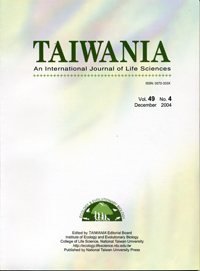Research Paper
Formation of Calcium Carbonate Deposition in the Cotyledons during he Germination of Justicia procumbens L. (Acanthaceae) Seeds
Miao-Ling Lin, Tsair-Bor Yen and Ling-Long Kuo-Huang
Published on: December 2004
Page: 250 - 262
DOI: 10.6165/tai.2004.49(4).250
Abstract
During seed germination of Justicia procumbens, the formation of lithocysts, trichomes and diacytic stomata in the epidermis of cotyledons was following a specific distribution pattern. During the first 1-3 days, many young stomata and trichome initial cells were formed sporadically in the adaxial and abaxial epidermis, but no lithocyst was found. Three to five days after seed sawing, two cotyledons were exposed to light and then opened. In the meantime, some lithocysts were recognized on both adaxial and abaxial epidermises. The lithocysts on the adaxial epidermis occurred in the radially arranged cells located between the central area and the margin. However on the abaxial epidermis, they were found only in the marginal cell layer and their axes were along the margin of cotyledons. The total number of lithocysts in a cotyledon at this stage was 32.2 ± 4.3 and the cystolith inside the lithocyst was spindle in shape and 48.2 ± 21.1 μm in length. Three weeks after seed sowing, the cotyledons were mature and the total number of lithocysts in a cotyledon was 112.2 ± 10.1 and the cystolith in the lithocyst was enlarged to be 119.8 ± 27.8 μm in length. The cystolith was extracellularly formed in the cell wall of lithocyst. Its surface was with many protuberances and surrounded by a cystolith sheath connecting to cytoplasmic strands. The core of cystolith was surrounded by concentrically stratified fibrils and the calcium carbonate was concentrically accumulated. The waved stratified fibrils were also deposited in the protuberances. The EDX spectra showed that the main mineral elemental compositions of cystoliths were Ca and P. Ca was deposited more in the central part of cystolith than in the marginal area.
中文摘要
爵床 (Justicia procumbens) 的種子發芽過程中,子葉表皮之石胞、毛茸、與氣孔的形成均遵循著特有的分布型式。在種子發芽的第1 至3 天,子葉仍包裹於種皮內,許多氣孔與毛茸始源細胞在子葉之向軸與背軸的表皮分散的形成,但並無觀察到石胞。當種子發芽3 至5 天後,兩片子葉突破種皮並打開,同時在子葉之向軸與背軸的表皮上都可區分出石胞。在子葉的向軸面,石胞僅形成於中央部位與周邊之間的放射狀排列細胞,而在背軸面,石胞則僅形成於子葉邊緣,其長軸並與子葉邊緣平行。此時期每片子葉平均有32.2 ± 4.3 個石胞,而其內的鐘乳體呈紡錘形,長48.2 ± 21.1 μm。當種子發芽3星期後,子葉已發育成熟,在子葉向軸面的中央區域,可觀察到許多石胞的形成,但在背軸面的中央區域則僅密佈氣孔,此時期每片子葉平均有112.2 ± 10.1 個石胞,而其內鐘乳體的長度則增加至119.8 ± 27.8 μm。鐘乳體沉積於石胞的細胞壁,外緣具有許多瘤狀突起並為鞘狀物所包圍,其外與細胞質絲所相連。鐘乳體之碳酸鈣沉積物呈向心的推積,其核心與邊緣部位為纖維層向心的層層堆積。X 光能微量元素分析顯示鐘乳體主要的無機元素為鈣與磷,鈣元素在鐘乳體之核心部位較其在邊緣部位堆積為多。
Keyword: Calcium carbonate deposition, Lithocyst, Cystolith, Cotyledon, Seed germination, EDX, Justicia procumbens


